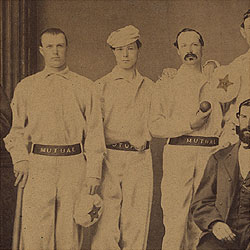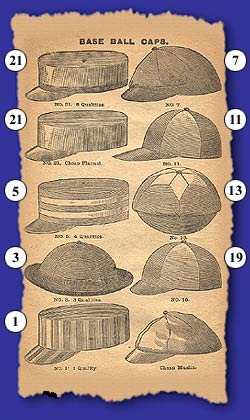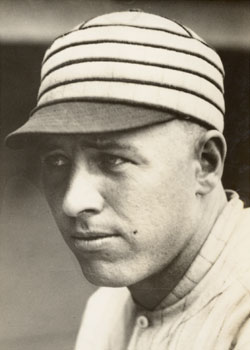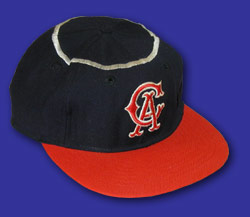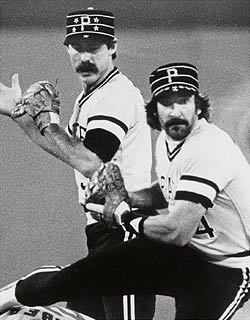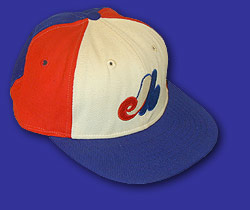 |
|
|
Caps
|
|
|
The baseball cap is the quintessential American hat. It is seen not just on the ball field, but in the stands, on the streets and even at the workplace. Today, as in the past, the baseball cap serves many functions. It shades a player’s eyes from the sun during the day and from artificial lights at night. It helps players and fans distinguish members of one team from another. A cap’s distinctive coloring and graphics help promote the team and make for an enticing retail product. And how could a club mount a late-inning comeback without displaying an inside-out “rally cap?” Old HatOn April 24, 1849, the New York Knickerbockers, baseball’s seminal organization, adopted the first official uniform. The first baseball caps were chip (or straw) hats. A few years later the club switched to a cap made of merino (a soft, fine wool) that featured the two main characteristics of the modern-day baseball cap: a crown and a bill (or visor).
|
|
|
|
A Star Is BorneAdvertisements in the late 1860s featured numerous styles for baseball caps. One of the most popular styles of the day, made by sporting goods manufacturer Peck & Snyder, was simply known as “No. 1.” The cap, worn by such top-flight amateur clubs as the Brooklyn Excelsiors, Philadelphia Athletics, New York Gothams and New York Mutuals, featured a star pattern atop the crown. Baseball caps of the late 1860s generally ranged in price from $1.25 to $2 each, depending on the grade of wool, with flannel being less expensive than merino. At left: Members of the Mutual Base Ball Club of New York City with stars atop their caps, 1864
|
Spalding Pitches CapsTen different cap styles were advertised in Spalding’s Base Ball Guide for 1888. Prices for caps of the era ranged from a low of 12 to 15 cents for cheap muslin and flannel caps, to $2 for the highest quality flannel. |
|
|
|
At left: Cap styles as advertised in Spalding’s Base Ball Guide of 1888
|
Burkett’s BillIn 1895, a number of ballplayers, including future Hall of Fame outfielder Jesse Burkett, experimented with baseball caps that had green-tinted, transparent bills. The idea was to allow the fielder a better range of view while protecting him from the glare of the sun, but apparently the see-through bills never caught on. Catch That TigerThe first big league club to place an image of its team nickname on its uniform cap was the Detroit Tigers of 1901 and ’02. In those seasons, the front of the Detroit cap was adorned with the likeness of a running orange tiger.
|
|
|
|
Stitch StoryIn 1903, Spalding introduced the “Philadelphia Style” cap, which featured an innovative first: the stitched visor. The subtle addition resulted in a longer-lasting cap that better retained its shape. By the end of the decade, nearly every baseball cap featured the stitched bill. At left: “Philadelphia Style” cap as advertised in Spalding’s Base Ball Guide of 1903
|
A Tip of the CapVery few clubs have donned baseball caps with two-toned bills. In 1908, the St. Louis Browns introduced a cap with a bill that was white with a thick trim of brown. The style lasted just three seasons. From 1912 through 1915, the Washington Nationals (later known as the Senators) donned caps with a dark blue bill with a thin trim of white.
|
|
|
|
Pennsylvania “Pillboxes” Produce Plenty of PennantsBy 1905, the “pillbox” baseball cap was rarely seen on big league diamonds, but the style did experience two noteworthy revivals. The Philadelphia Athletics donned a horizontally striped “pill box” cap from 1909 through 1914. The old-fashioned style evidently worked wonders as Connie Mack’s club won four American League pennants and three World Series Championships during the six years the cap was worn. The distinctive caps can be seen on the Hall of Fame plaques of three members of this Athletics dynasty: Frank Baker, Chief Bender, and Eddie Plank. The striped “pillbox” cap also made a comeback in 1976 when five National League clubs celebrated the “Senior Circuit’s” 100th anniversary by adopting the nostalgic style. While the Reds, Mets, Phillies and Cardinals wore the caps during the centennial season alone, the Pittsburgh Pirates retained the style from 1976 through 1986, including their Championship season of 1979. At left: Philadelphia Athletics outfielder Jimmy Walsh with the striped “pill-box cap,” 1914
|
No-Go LogoThe last big league club to don a cap without a letter or logo on the front was the 1945 St. Louis Browns, who wore a white cap with thin orange and brown stripes and a solid brown bill. One-Size-Fits-AllThough today’s big league clubs still use fitted caps, the clubs of the All-American Girls Professional Baseball League of the 1940s and ’50s used caps with elastic bands in the back so that they were one-size-fits-all.
|
|
|
|
Angels Say “Halo”Just a few weeks into their inaugural season of 1961, the American League Los Angeles Angels adopted caps with a silver halo on the crown. The Angels’ halo cap lasted through the 1970 season, after which the design element was removed from the top of the cap and a small halo was incorporated into the team’s logo. At left: Baseball cap worn by California Angels pitcher Clyde Wright, 1970
|
Captain’s CapsThe short-lived Seattle Pilots of 1969 incorporated an ingenious graphic element on the bill of their caps: two golden braids (sometimes referred to as “scrambled eggs”) similar to those worn on the hats of U.S. Navy officers and commercial airline captains. When the club moved to Milwaukee just prior to the 1970 season, the team was renamed and the creative cap design abandoned.
|
|
|
|
Stars and StripesWhile the Pittsburgh Pirates of 1976-1986 wore the old-fashioned, striped “pill box” cap, their most innovative alteration to the baseball cap was introduced in 1978 and made famous during their championship season of 1979. In a practice reminiscent of the merit badges doled out by Coach Woody Hayes of the Ohio State Buckeyes football team, Willie Stargell handed out gold “Stargell Stars” to teammates in recognition of various on-field achievements. The stars were then sewn to the honored player’s cap, either between the horizontal stripes or on the bill. Stargell later introduced stars with a small letter “S” in the center, but the merit badges lasted just a few seasons. When Stargell passed away in 2001, the Pirates donned a “Stargell Star” on the front of their jersey in memory of “Pops.” At left: Pirates infielders Phil Garner (left) and Dale Berra with “Stargell Stars” on their striped caps, 1980
|
|
|
Rouge, Blanc et BleuPerhaps the most striking baseball cap of modern times was worn by the Montreal Expos from 1969 to 1991. The six panels that made up the crown were colored red, white and blue, matching the color scheme of the club’s logo At left: Baseball cap worn by Montreal Expos pitcher Bill Stoneman, 1969
|
|
Dressed to the Nines: A History of the Baseball Uniform |
|
